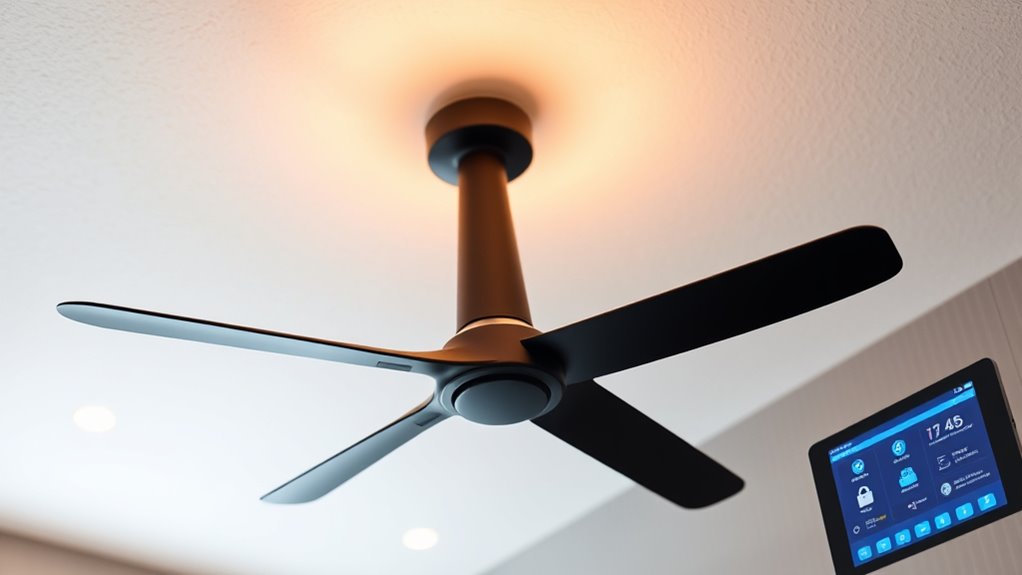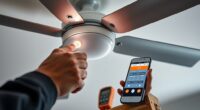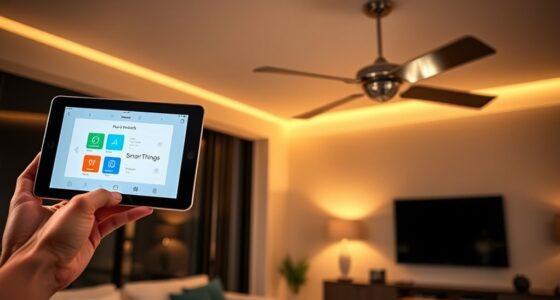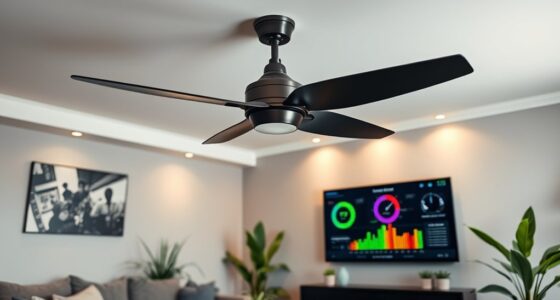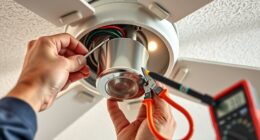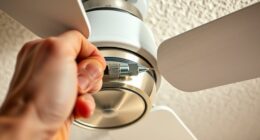When using smart ceiling fans, it’s essential to analyze their privacy and security features. Make sure they use strong encryption protocols like TLS for data in transit, and change default passwords to prevent unauthorized access. Regular firmware updates and secure communication with cloud services minimize vulnerabilities. Network segmentation and physical security practices further protect your home. Carefully review privacy policies to understand data collection and storage. Continued examination reveals key steps to safeguard your smart fan against potential cyber threats.
Key Takeaways
- Ensure the fan uses strong encryption protocols like TLS for data in transit and secure authentication methods.
- Review privacy policies to understand data collection, storage, and sharing practices of the manufacturer.
- Regularly update firmware and software to patch vulnerabilities and protect against cyber threats.
- Change default passwords and enable multi-factor authentication to prevent unauthorized access.
- Segment your home network to isolate smart fans from critical devices and enhance overall security.
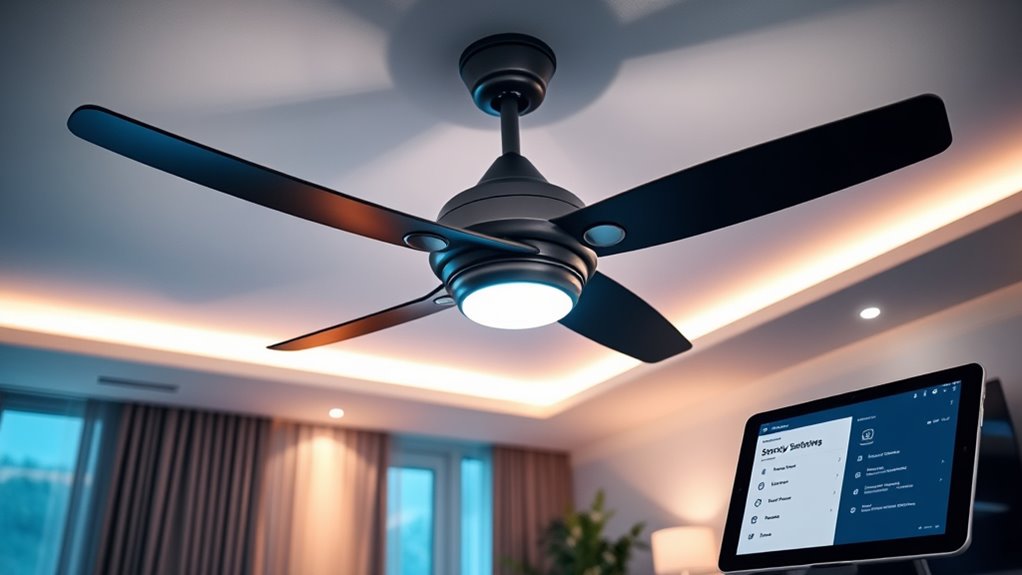
As smart ceiling fans become increasingly integrated into home automation systems, understanding their privacy and security implications is essential. These devices often connect to Wi-Fi networks, enabling remote control, scheduling, and integration with voice assistants, but this connectivity also introduces potential vulnerabilities. When you install a smart ceiling fan, you’re effectively adding a networked device that can collect data on your usage patterns, environmental conditions, and even voice commands if integrated with voice control systems. Without proper safeguards, this data can be intercepted, misused, or leaked, jeopardizing your privacy. Moreover, the firmware and software running on these devices may contain vulnerabilities that, if unpatched, expose your home network to malicious actors. It’s crucial to scrutinize the security architecture of the fan, including how it authenticates users and communicates with cloud services, to prevent unauthorized access.
You need to be aware that many smart fans rely on proprietary or third-party cloud services to function fully, which introduces additional security considerations. If these cloud servers are compromised or if their data transmission isn’t adequately encrypted, hackers could potentially intercept sensitive information or manipulate device behavior. For instance, a malicious actor might gain control of your fan’s settings, disrupt operation, or use it as a foothold to access other devices on your network. To mitigate these risks, ensure that the device employs strong encryption protocols such as TLS for data in transit and robust authentication mechanisms. Regular firmware updates are essential, as they often contain patches for known vulnerabilities. You should also verify that the manufacturer supports security updates over the long term, reducing the risk posed by outdated software.
Another critical aspect is user authentication and access control. Default passwords or weak credentials can be exploited by attackers to gain unauthorized control. Changing default credentials and implementing multi-factor authentication where available significantly enhances security. Network segmentation can also serve as a protective barrier, isolating your smart devices from your primary network, thereby limiting potential damage if a device is compromised. Additionally, understanding what data your smart ceiling fan collects and how it’s stored or transmitted is vital; review privacy policies and permissions to ensure minimal data collection and transparency. Consider also the importance of cybersecurity vulnerabilities in smart devices, which emphasizes why ongoing vigilance is necessary. Finally, understand what data your smart ceiling fan collects and how it’s stored or transmitted is vital; review privacy policies and permissions to ensure minimal data collection and transparency. Finally, consider the physical security implications—if the device can be accessed or manipulated physically, ensure it’s installed securely to prevent tampering. By adopting a comprehensive, proactive security approach, you can greatly reduce the privacy risks associated with smart ceiling fans, ensuring they function safely and securely within your home automation ecosystem.
Frequently Asked Questions
Can Smart Ceiling Fans Be Hacked Remotely?
Yes, smart ceiling fans can be hacked remotely if they lack proper security measures. Hackers exploit vulnerabilities like weak passwords, outdated firmware, or unsecured Wi-Fi networks. Once compromised, they can gain control over the fan’s functions or access your network. To prevent this, guarantee your device firmware is up-to-date, use strong, unique passwords, enable two-factor authentication, and secure your Wi-Fi with WPA3 encryption.
What Data Do Smart Ceiling Fans Collect?
Smart ceiling fans collect data like your room temperature, humidity, fan usage patterns, and device status, acting as digital spies quietly observing your environment. They also track your Wi-Fi connection details, app interactions, and sometimes even voice commands if integrated with smart assistants. This data helps optimize performance but can expose sensitive information if not secured properly. Think of it as a silent observer, always gathering insights to improve your comfort.
How Secure Are the Wi-Fi Connections for Smart Fans?
Your Wi-Fi connections for smart ceiling fans are generally secure if you implement proper measures. Most devices use WPA3 encryption, which offers robust protection against eavesdropping and unauthorized access. Regular firmware updates patch vulnerabilities, and strong, unique passwords further enhance security. Avoid unsecured networks, and enable two-factor authentication where available. By taking these steps, you considerably reduce risks, making your smart fan’s Wi-Fi connection more resilient against cyber threats.
Are There Privacy Risks With Voice Control Features?
Yes, voice control features pose privacy risks as they constantly listen for commands, potentially capturing sensitive conversations. Data transmitted to cloud servers may be intercepted or stored without your explicit knowledge, increasing vulnerability to breaches. Unauthorized access or hacking could enable malicious actors to eavesdrop or manipulate your devices. To mitigate these risks, verify your network is secure, disable voice recording when not needed, and review privacy settings regularly.
What Should I Do if My Smart Fan Is Compromised?
Think of your smart fan as a locked treasure chest; if it’s compromised, you must act swiftly. First, disconnect it from your Wi-Fi to prevent further access. Then, reset the device to factory settings, update its firmware, and change all associated passwords. Check for unauthorized activity in your network logs, and consider alerting your manufacturer or tech support for ongoing security measures. This proactive approach safeguards your digital environment.
Conclusion
As you navigate the integration of smart ceiling fans into your home, remember that meticulous attention to security protocols and privacy settings is vital. Coincidences like unexpected data access or device malfunctions highlight the importance of robust encryption and regular firmware updates. By proactively managing these factors, you guarantee your environment remains both comfortable and protected, turning what seems like simple coincidence into deliberate control—transforming your smart fan from a potential vulnerability into a secure, seamless part of your connected ecosystem.
